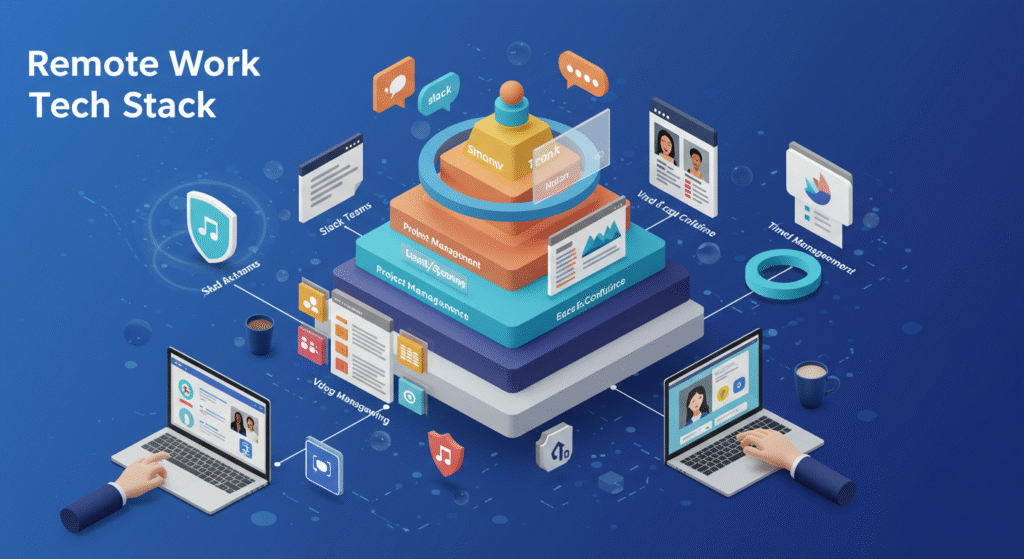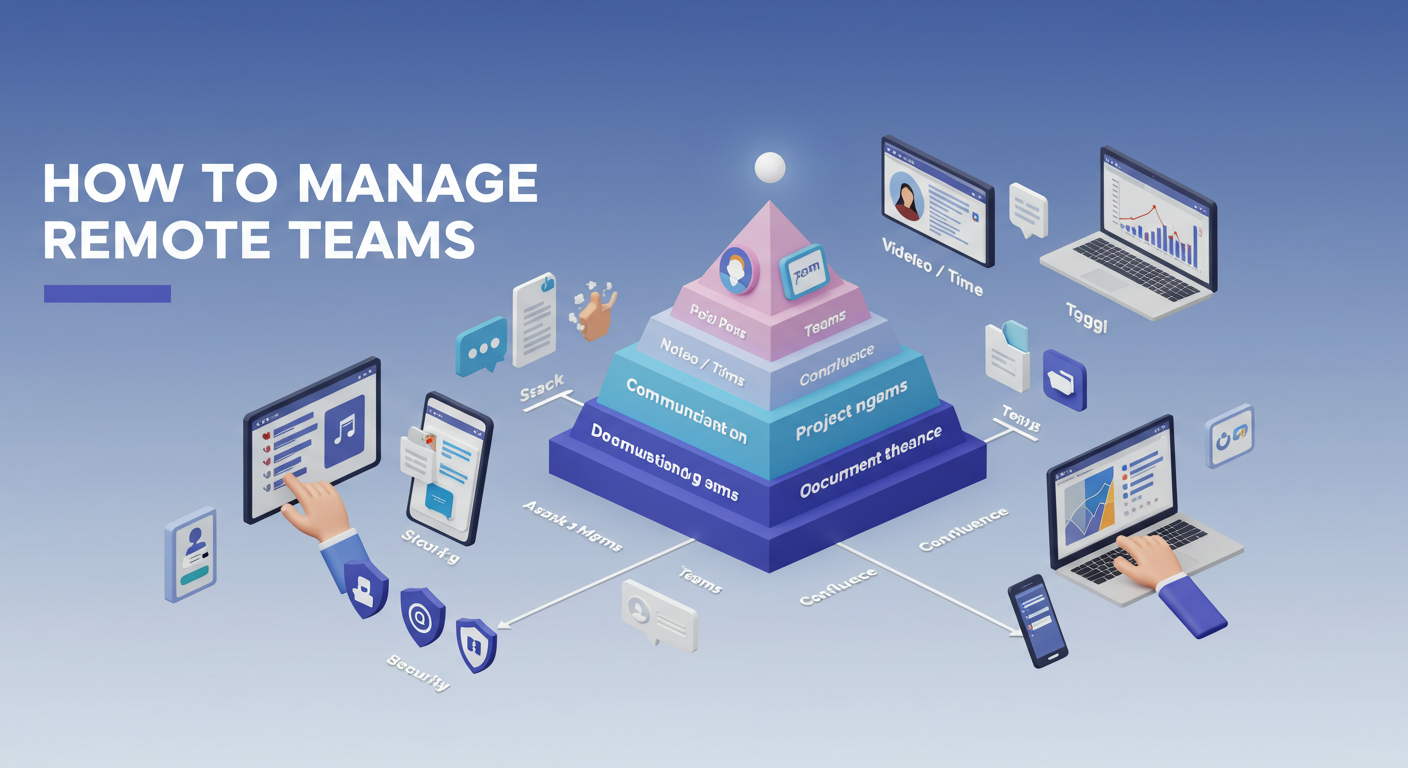Ultimate Guide For How To Manage Remote Teams
The global workforce has undergone a dramatic transformation, with remote work becoming a permanent fixture rather than a temporary solution. As businesses adapt to this new reality, learning how to manage remote teams effectively has become a critical skill for modern leaders. Whether you’re a startup founder, a project manager at a mid-sized company like UpsourceMedia.com, or an executive at a large corporation, mastering remote team leadership is essential for maintaining productivity, engagement, and business continuity.
This comprehensive guide will explore:
- Foundational principles for working with remote teams
- Advanced remote team management tips
- Essential tools for managing remote employees
- Solutions to common challenges of managing remote teams
- Cutting-edge best practices for remote teams
By implementing these strategies, you’ll be able to lead remote teams with confidence, regardless of your industry or team size.

Building the Foundation for Effective Remote Team Management
Establishing Clear Communication Protocols
Working effectively with remote teams begins with creating robust communication frameworks. Unlike traditional office environments where spontaneous conversations happen naturally, managing remote work requires intentional communication strategies.
Key Components for how to manage remote teams:
- Structured Communication Channels
- Instant messaging (Slack, Microsoft Teams) for quick questions
- Email for formal communications and documentation
- Video conferencing (Zoom, Google Meet) for complex discussions
- Project management tools (Asana, Trello) for task-related updates
- Communication Frequency Guidelines
- Daily check-ins for quick alignment
- Weekly one-on-ones for deeper discussions
- Monthly all-hands meetings for company-wide updates
- Response Time Expectations
- Urgent matters: 1-hour response window
- Normal priority: 4-hour response window
- Low priority: 24-hour response window
At UpsourceMedia.com, we’ve found that implementing a “communication charter” that outlines these expectations significantly reduces misunderstandings in distributed teams.
Setting and Tracking Remote Team Goals
Managing remote employees successfully requires a shift from time-based to outcome-based performance measurement. This approach aligns perfectly with remote work best practices , where flexibility and results matter more than physical presence.
Goal-Setting Framework for Remote Teams:
- OKRs (Objectives and Key Results)
- Company-level objectives
- Department-level key results
- Individual contributor milestones
- SMART Goals
- Specific, Measurable, Achievable, Relevant, Time-bound targets
- Progress Tracking
- Weekly progress reports
- Bi-weekly sprint reviews
- Quarterly performance evaluations
Advanced Remote Team Management Strategies
Fostering Trust and Accountability
Leading remote teams effectively requires a delicate balance between autonomy and accountability. Unlike in-office environments where managers can physically observe work, managing remote teams demands trust-based systems.
Trust-Building Techniques:
- Results-Oriented Management
- Focus on deliverables rather than activity
- Implement weekly demo days to showcase work
- Transparent Work Processes
- Public task boards (using tools like Jira or Monday.com)
- Shared calendars showing availability
- Regular Feedback Loops
- 360-degree feedback systems
- Real-time recognition programs
Case Study: A tech startup at UpsourceMedia.com increased productivity by 32% after shifting from hourly tracking to outcome-based performance metrics.
Overcoming Time Zone Challenges
One of the most significant remote teams challenges is coordinating across multiple time zones. Managing remote development teams, for instance, often requires synchronizing work between continents.
Time Zone Management Strategies:
- Core Overlap Hours
- Establish 3-4 hours when all team members are available
- Schedule critical meetings during this window
- Asynchronous Communication Practices
- Loom video updates for non-urgent matters
- Detailed project documentation in Notion or Confluence
- Meeting Rotation
- Alternate meeting times to share the inconvenience
- Record all meetings for absent team members
Essential Tools for Remote Team Success
The Remote Work Tech Stack
To manage distributed teams effectively, having the right tools is non-negotiable. Here’s a categorized breakdown of essential remote team management tools:
| Category | Top Tools | Key Features |
|---|---|---|
| Communication | Slack, Microsoft Teams | Real-time messaging, threaded conversations |
| Project Mgmt. | Asana, Trello, ClickUp | Task assignments, Gantt charts, workflows |
| Documentation | Notion, Confluence | Centralized knowledge base, wikis |
| Video Conferencing | Zoom, Google Meet | HD video, breakout rooms, recording |
| Time Management | Toggl, Harvest | Time tracking, productivity analytics |
| Security | LastPass, 1Password | Secure password management |
At UpsourceMedia.com, we use a combination of Slack for communication, Asana for project management, and Notion for documentation to manage our remote team effectively.

Specialized Tools for Remote Development Teams
Managing remote development teams requires additional technical tools:
- Code Collaboration: GitHub, GitLab, Bitbucket
- Pair Programming: VS Code Live Share, Tuple
- DevOps: Docker, Kubernetes, Jenkins
- Virtual Whiteboarding: Miro, FigJam
Cultivating Remote Team Culture
Building Connection in Virtual Teams
Successful remote teams invest heavily in culture-building activities to combat isolation—one of the most common challenges managing remote teams.
Culture-Building Activities:
- Virtual Coffee Chats
- Randomly paired weekly video calls
- Non-work conversation prompts
- Online Team Building
- Virtual escape rooms
- Multiplayer online games
- Recognition Programs
- Monthly “shout-out” channels
- Peer-nominated awards
Onboarding Remote Employees Effectively
How to bring remote teams together starts with a stellar onboarding process:
- Pre-Boarding Kit
- Welcome package (shipped to their home)
- Digital employee handbook
- Structured 30-60-90 Plan
- Clear milestones for the first three months
- Assigned onboarding buddy
- Cultural Immersion
- Virtual lunch with team members
- Participation in non-work Slack channels
Measuring and Optimizing Remote Team Performance
Key Performance Indicators for Remote Teams
To manage remote teams effectively, you need to track the right metrics:
- Productivity Metrics
- Tasks completed
- Cycle time
- Code quality (for dev teams)
- Engagement Metrics
- Survey scores (eNPS)
- Meeting participation rates
- Slack/Teams activity levels
- Business Outcomes
- Project delivery timelines
- Customer satisfaction scores
- Revenue impact
Continuous Improvement Strategies
Best practices managing remote employees include regular optimization:
- Quarterly Retrospectives
- What worked well?
- What needs improvement?
- Action items for next quarter
- Tool Audits
- Evaluate if current tools still meet needs
- Pilot new solutions annually
- Training Programs
- Remote team management training for leaders
- Digital skills workshops for all employees

Frequently Asked Questions.
1. What are the most effective ways to monitor remote workers without micromanaging?
Focus on output rather than activity. Use project management tools to track deliverables and implement regular (but not excessive) check-ins. Trust is key when you manage teams remotely.
2. How can I improve collaboration between remote team members?
Encourage the use of collaborative documents (Google Docs, Notion), implement pair programming or peer reviews, and create virtual “water cooler” spaces for informal interactions—all part of working effectively with remote teams.
3. What are the best strategies for managing remote meetings?
- Always have an agenda
- Keep meetings under 45 minutes
- Assign action items
- Record sessions for those who can’t attend
These remote work communication best practices ensure productive virtual meetings.
4. How do you handle different time zones when managing global remote teams?
Establish core overlap hours, rotate meeting times fairly, and emphasize asynchronous communication—critical for leading remote teams across continents.
5. What technical infrastructure is needed to support remote work?
At minimum: reliable VPN, cloud-based collaboration tools, cybersecurity measures, and hardware stipends for employees. Companies like UpsourceMedia.com often provide home office budgets.
6. How can I maintain company culture with a remote team?
Regular virtual social events, transparent communication from leadership, and cultural rituals translated to digital formats help sustain culture when managing remote working arrangements.
Conclusion
Managing remote teams effectively requires a combination of the right mindset, tools, and processes. By implementing the strategies outlined in this guide—from establishing clear communication protocols to fostering strong remote cultures—you’ll be well-equipped to lead remote teams successfully.
Remember that remote team management is an evolving discipline. What works today may need adjustment tomorrow. Stay flexible, continuously gather feedback from your team, and don’t hesitate to experiment with new approaches.
For organizations looking to deepen their remote team leadership capabilities, UpsourceMedia.com offers specialized consulting services to help you optimize your distributed workforce. Visit our contact page to learn more about how we can support your remote work initiatives.
By embracing these best practices for remote teams, you’ll not only overcome the challenges of managing remote employees but also unlock the full potential of your distributed workforce—driving innovation, productivity, and employee satisfaction in today’s digital-first world.


